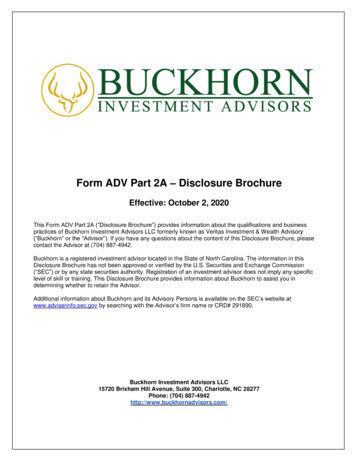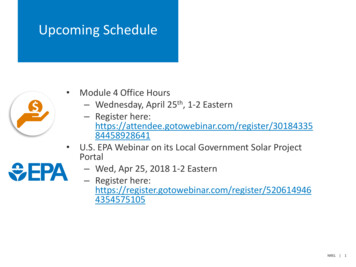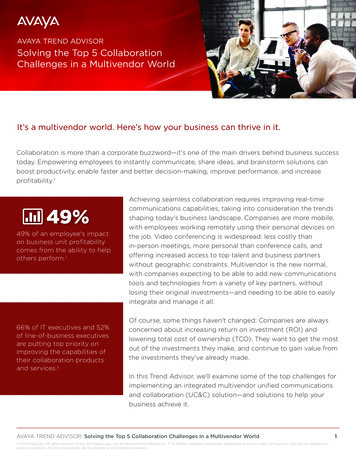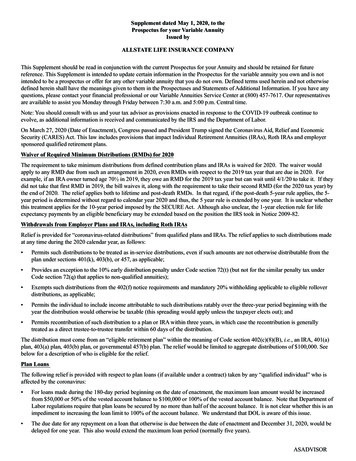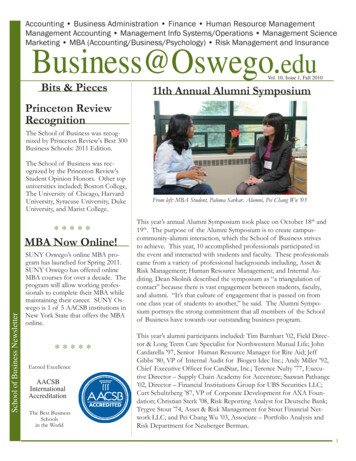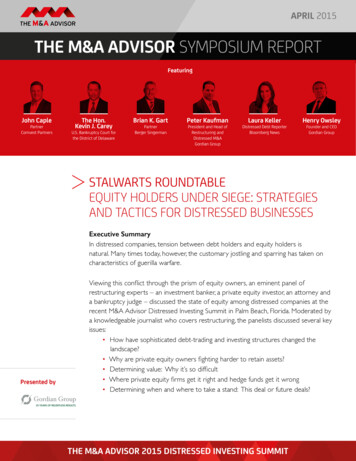
Transcription
APRIL 2015THE M&A ADVISOR SYMPOSIUM REPORTFeaturingJohn CaplePartnerComvest PartnersThe Hon.Kevin J. CareyU.S. Bankruptcy Court forthe District of DelawareBrian K. GartPartnerBerger SingermanPeter KaufmanPresident and Head ofRestructuring andDistressed M&AGordian GroupLaura KellerDistressed Debt ReporterBloomberg NewsHenry OwsleyFounder and CEOGordian GroupSTALWARTS ROUNDTABLEEQUITY HOLDERS UNDER SIEGE: STRATEGIESAND TACTICS FOR DISTRESSED BUSINESSESExecutive SummaryIn distressed companies, tension between debt holders and equity holders isnatural. Many times today, however, the customary jostling and sparring has taken oncharacteristics of guerilla warfare.Presented byViewing this conflict through the prism of equity owners, an eminent panel ofrestructuring experts – an investment banker, a private equity investor, an attorney anda bankruptcy judge – discussed the state of equity among distressed companies at therecent M&A Advisor Distressed Investing Summit in Palm Beach, Florida. Moderated bya knowledgeable journalist who covers restructuring, the panelists discussed several keyissues: How have sophisticated debt-trading and investing structures changed thelandscape? Why are private equity owners fighting harder to retain assets? Determining value: Why it’s so difficult Where private equity firms get it right and hedge funds get it wrong Determining when and where to take a stand: This deal or future deals?THE M&A ADVISOR 2015 DISTRESSED INVESTING SUMMIT
EQUITY HOLDERS UNDER SIEGE: STRATEGIES AND TACTICS FOR DISTRESSED BUSINESSESFrom The M&A AdvisorEquity owners and creditors. In the world of distressed investing these days, these twocamps sometime seem like Hatfields and McCoys in bespoke suits.Yes, equity owners are lower than creditors in the capital pecking order, but just wherelines are drawn and how the divvying actually gets done can lead to some serious feuding.To gain insights into the role of equity owners in today’s troubled companies, we devoteda full session to this issue at our recent 2015 Distressed Investing Summit in Palm Beach,Florida.Our Stalwarts Roundtable led off with an introduction by Peter Kaufman, President andHead of Restructuring and Distressed M&A at Gordian Group, as well as co-author, withhis partner Henry Owsley, of Distressed Investment Banking: To the Abyss and Back, and therecently published Equity Holders Under Siege: Strategies and Tactics for Distressed Businesses.The session was skillfully moderated by Laura Keller, a distressed debt reporter atBloomberg News, and was studded with keen observations by our panelists: John Caple,a Partner at Comvest Partners; The Hon. Kevin J. Carey, U.S. Bankruptcy Court for theDistrict of Delaware; Brian K. Gart, a Partner at Berger Singerman; and Henry Owsley,Founder and CEO of Gordian Group, which presented the session.Like the Summit’s eight other Conversations, Roundtables, along with a special Case Studyon Detroit’s restructuring, this session provided attendees with an unusual opportunityto share ideas with some of the best minds in the business. The M&A Advisor greatlyappreciates the panelists’ contribution to the Summit and is delighted to share theirviews with you.David FergussonPresident and Co-Chief Executive OfficerThe M&A AdvisorPresented by
EQUITY HOLDERS UNDER SIEGE: STRATEGIES AND TACTICS FOR DISTRESSED BUSINESSESContentsPresented byThe Value of Control1Why the Changed Mood2Equity’s Role2Keep or Ditch Management4In Court? Out of Court?4Video Interviews6Symposium Session Video8Symposium Participant Profiles9About the Sponsor11About the Publisher12
EQUITY HOLDERS UNDER SIEGE: STRATEGIES AND TACTICS FOR DISTRESSED BUSINESSESThe Value of ControlHenry Owsley does not necessarily adhere to the absolute priority rule that puts creditors’claims above those of equity holders in lockstep order. Mr. Owsley, Founder and Chief ExecutiveOfficer of Gordian Group — and co-author with Peter Kaufman of both Distressed InvestmentBanking: To the Abyss and Back and the recently published Equity Holders Under Siege: Strategiesand Tactics for Distressed Businesses — kicked off the symposium by explaining that whilecreditors’ claims come first, those with claims lower down the line also deserve something.“In the privateequity world, theability to garnerincrementalportfolio returnthrough afocus on yourunderperformerscan be thedifferencebetween raisingyour next fundand not.”“We firmly believe that lower constituencies — and particularly those of the equity stripe —have option value, because things can improve down the road; they have control value, at leastinitially,” Mr. Owsley said, “And certainly, in an out-of-court setting, those factors enable old equityconstituencies to claw for meaningful recoveries.”– Henry OwsleyAs “the guy” often in the seat deciding when and how hard to fight, John Caple of ComvestPartners said he considers many factors, weighing the present against the future.For private equity firms, those recoveries can be critical.“In the private equity world, the ability to garner incremental portfolio return through a focus onyour underperformers can be the difference between raising your next fund and not. That’s thedifference between being in business as a PE firm and retiring to the beach,” said Mr. Owsley.The key questions, then, for many equity owners are when and to what degree they assert theirpower, whatever it may be.“First, how far out of the money are you? Are we really going to go to war over five cents? Afterall, five cents and zero are sort of the same thing to me,” Mr. Caple said. “If I’m going to haveto spend the next two years of my life fighting for five cents, I can make more money in otherplaces.”Mr. Caple said that many of the lenders are those who were there in the beginning, particularlyin the lower and middle market, “and you have to decide whether you’re going to go to war onthose guys.”Presented byOftentimes, he said, it’s a decision about fighting for value or fighting for time. “In private equityland, it’s more important to fight for time,” explaining that because as long as the company is notin bankruptcy and owners still hold equity, “I can make all sorts of arguments about what thatmight be worth.”Limited partners understand the concept of working on a troubled company, Mr. Caple said,adding that in his experience, those partners aren’t happy “when I have to take that five cents orzero.”1
EQUITY HOLDERS UNDER SIEGE: STRATEGIES AND TACTICS FOR DISTRESSED BUSINESSESWhy the Changed MoodSo what’s behind the growing contentiousness between debt and equity holders? Laura Kellerasked whether the increased presence of private equity has been the driver.“Are we reallygoing to go towar over fivecents?”– John Caple“What I’m seeing is that so much of the debt is trading before anything really gets going orhappens that there’s no relationship anymore for the sponsor who brought them into the deal,”said Brian K. Gart, a Partner at Berger Singerman in Ft. Lauderdale, Florida. “They’re out to extracttheir pound of flesh much earlier in the case.”John Caple agreed, noting that once a distressed fund owns debt, everything changes.“They’re going to go out and assert their rights — well, then, I will too,” Mr. Caple said. “You justvery quickly get to a much more contentious situation than one with a relationship lender whomight give me some extra time and might let me go down the path and allow us to work it outtogether.”Time is important, Mr. Owsley noted, especially in the negotiating process.“We note in the book that many distressed funds have target internal rates of return of 15, 20,25 percent or even higher, and by dint of waiting for time, their IRR declines,” he said. “If you cancut a quick deal with them, they may be willing to compromise on their principal recovery inorder to facilitate a rapid exit.”The shorter-term focus of the managers of distressed debt funds has put greater emphasis onstriking deals more quickly and moving on, the panelists said.“Today, by the time a company gets to bankruptcy, nobody who was there at the beginning is stillthere, including trade creditors,” added Judge Carey. “You have unsecured creditors’ committeesfilled with no one who ever extended credit to the debtor initially.”And the turnover of ownership isn’t limited to the creditor side.Presented by“Oftentimes, by the time a PE deal gets into bankruptcy, that PE partner is fired,” Mr. Caple noted.“In fact, I would make the argument that if one of your existing portfolio companies is in trouble,you are the world’s greatest investor that the company because no one knows as much aboutit as you do. PE firms should really be putting more money into their existing companies, butpsychologically that’s almost impossible — it was a bad deal, everyone in the firm is annoyedabout it, they’ve decided they hate the industry — so they’re just unable to put more money in.”Equity’s RoleSo, asked Ms. Keller, is the new aggressiveness of equity owners a response to aggressivedistressed creditors — or a result of changes in the equity world?2
EQUITY HOLDERS UNDER SIEGE: STRATEGIES AND TACTICS FOR DISTRESSED BUSINESSES“Part of it is that distressed creditors allow you to play these games and part that private equityguys have been very aggressive and it’s worked. They’ve done some things that arguably werequestionable, but it’s to show that they are really smart and that it’s the right way to play thegame,” said Mr. Caple. “Act first and ask for permission later.”Mr. Owsley agreed.“PE is fighting toretain the assetand providesome return tofund investors; inthe past, it wasall about gettingthe release.”– Brian Gart“If people anticipate that bankruptcy is a year or more out in advance, they’re taking certainstructural steps to position themselves. They’re moving assets around or even dividending them,”Mr. Owsley said. “It certainly sets you up for a fraudulent conveyance lawsuit, so it generateslitigation. But many people do it and let the chips fall. Some of us may think it’s too aggressive, butit certainly is within the aggressive framework of what people do.”But not all equity investors are so aggressive. In fact, John Caple believes that private equityinvestors who do distress deals and those that do healthy deals are “very, very different animals.”“The guys who do healthy deals don’t understand this stuff and don’t think about it until theyget to the very end. And when they get to the very end, they don’t really think like a distressednegotiator; they think like an equity negotiator,” Mr. Caple said.PE investors who have been through a distressed situation and focus on distressed M&A andrestructuring deals understand their responsibilities and fiduciary duties as a sponsor, Mr. Gartnoted, pointing out that they also want to anticipate what creditors will want when the timecomes.“They’ve got their people off the board early and have found an independent director to stepin,” Mr. Gart said. “They’ve decided whether or not they’re going to be a buyer for the companyagain or whether they’re going to work with the creditors to transition it to the lender and letthe creditors be the new equity.”What’s happening now, he added, is that private equity “is fighting more to retain the asset and toprovide some return to their fund investors. In the past, it was all about just getting the release.”But creditors or bond holders now won’t give releases without examining the fees and whateverelse equity owners took out in the recent past, Mr. Gart said, so equity owners want to be aheadof all that.Presented byMs. Keller then asked if there is a downside to PE aggressiveness, perhaps in terms of reputationcost if a portfolio company lands in bankruptcy.“It depends on who you are,” Mr. Caple said. “If you’re a distressed fund, it’s a lot easier. But ifyou’re a fund that’s go-go growth, you don’t want to have bankruptcy next to your name. And3
EQUITY HOLDERS UNDER SIEGE: STRATEGIES AND TACTICS FOR DISTRESSED BUSINESSESoftentimes those guys will do a lot and pay a lot to keep bankruptcy away from their name —and you can extract value from them.”On the other hand, he added, there are many investors who do tougher deals and theyrecognize that bankruptcy can be part of a longer-term strategy.Keep or Ditch Management“I haven’t seena lot of caseswhere the guyswho ran thebusiness intothe ditch getmore time andthen everythingis great.”– Henry OwsleyWhen companies — whether run by founders or other managers — face problems, shouldmanagement be replaced? Laura Keller asked this question to the panelists after John Capleexpressed doubts about giving more time to managers who were present as the companybecame undone.“While there are a lot of reasons for business failure — an individual driving the company intoa ditch, exogenous factors, or running out of money — I haven’t seen a lot of cases where theguys who ran the business into the ditch get more time and then everything is great,” said Mr.Owsley.Mr. Caple then responded: “I find that the best companies find a way to work through theexogenous factors. If you’re in a business with exposure to oil, for example, maybe you shouldhave hedged. I very rarely see businesses with great management teams that are being runwell end up in distress. On the other hand, in almost every poorly run business there are somegood members of management that aren’t given the right opportunities. But the concept that abusiness will get itself in trouble and then fix itself .I just don’t see it very often.”Returning to an earlier point on absolute priority, Judge Carey said that he now has two cases inwhich equity is keeping its interest or is being paid for it.“In one case, the unsecured creditors are getting 100 cents on the dollar, which is easy tosay and hard to do. The second is a pre-pack. So maybe that’s an effective way to have equitycontinue to play — by not having to get into bankruptcy and deal with the absolute priority,”Judge Carey said.In Court? Out of Court?Because of the time frames of bankruptcy and other restrictions, out-of-court arrangements andearly problem recognition are more important than ever for old equity, Mr. Owsley said.Presented byOne problem that Judge Carey said he finds is that equity owners tend to overvalue theirbusinesses, especially as they are based on rosy projections of the future which are hard toassess in the present.“I think this is where you see a big difference between corporate owners and private equity,”said Mr. Caple, who noted that family owners or entrepreneurs may fall in love with theirbusinesses, but private equity owners know exactly where the value is.4
EQUITY HOLDERS UNDER SIEGE: STRATEGIES AND TACTICS FOR DISTRESSED BUSINESSESFor those involved in a restructuring, how do valuations really work?“A valuation fight is never just a valuation fight,” said Judge Carey. “It starts at the beginning of thecase, with the party that’s got a subordinated position — which everyone says is out of the money— objecting to everything. If things aren’t resolved before you get confirmation, then you have thevaluation fight, but it’s been preceded by many battles along the way.”“A valuation fightis never just avaluation fight.”– Hon. Kevin CareyUnfortunately, said the Judge, when parties can’t come to a consensus on value, they leave thedecision to the least expert person — him.“But at least I’m neutral,” he said.One panelist asked why judges continue to use discounted cash flow as the yardstick of value whenthere are other valuation tools.“Judges don’t suggest what methods the parties should use. The parties suggest the method to thecourt, and that’s the one most frequently recommended,” Judge Carey said.Fights over value, he said, come most frequently when some constituents argue that those whobought at a discount are trying to extract more than their fair share of enterprise value — andthat’s why they fight.“I think that’s the dynamic that’s real, not that anyone ever stands up in court and says it,” JudgeCarey said.Brian Gart believes that private equity owners know true value. They “rarely get deal thrill”and rarely get business valuation wrong, he said, observing that these owners tend to look atrestructuring very analytically.“Most of the private equity folks we represent have a decision tree and they know how much it’sgoing to cost to run the process and the bankruptcy and do the sale. They also know how muchit’s going to cost to stay out of bankruptcy,” Mr. Gart said. “They compare the two decision trees; it’spretty formulaic.”The bottom line, however, is that the bankruptcy process is expensive, not only in direct costs butalso in its toll on the business, Mr. Caple said.Presented by“One of the big advantages that I have [as equity] is that I can make everyone go down that road if Iwant to, and it’s something that can be traded for value, if I want to do that,” he said.“It’s a moratorium that buys you time; time is your friend, and the longer you stretch things out themore valuable option it is,” concluded Mr. Owsley.5
EQUITY HOLDERS UNDER SIEGE: STRATEGIES AND TACTICS FOR DISTRESSED BUSINESSESVideo InterviewsTo watch exclusive M&A Advisor interviews with these restructuring industryexperts, click on the following images:Peter KaufmanPresident and Head of Restructuringand Distressed M&AGordian GroupHenry OwsleyFounder and CEOGordian GroupThe Hon.Kevin J. CareyU.S. Bankruptcy Court forthe District of DelawarePresented by6
EQUITY HOLDERS UNDER SIEGE: STRATEGIES AND TACTICS FOR DISTRESSED BUSINESSESBrian K. GartPartnerBerger SingermanJohn CaplePartnerComvest PartnersPresented by7
EQUITY HOLDERS UNDER SIEGE: STRATEGIES AND TACTICS FOR DISTRESSED BUSINESSESSymposium Session VideoTo watch the Stalwarts Roundtable – “Equity Holders Under Siege: Strategiesand Tactics for Distressed Businesses,” click on the following image:Equity Holders UnderSiege: Strategies andTactics for DistressedBusinessesPresented by8
EQUITY HOLDERS UNDER SIEGE: STRATEGIES AND TACTICS FOR DISTRESSED BUSINESSESSymposium Participant ProfilesJohn CaplePartnerComvest PartnersThe Hon.Kevin J. CareyU.S. Bankruptcy Courtfor the District ofDelawareBrian K. GartPartnerBerger Singerman9John Caple is a Partner at Comvest Partners. John has led investments in a variety of industrysectors including transportation/logistics, business services, retail/consumer and industrials. Johnis responsible for all key aspects of the investment process with extensive experience in assistingcompanies with both balance sheet and operational restructurings. John serves as a member ofthe Firm’s Investment and Executive Committees. Prior to joining Comvest, John was a Principalat Bayside Capital, the distressed investing vehicle of HIG Capital. Prior to that, John was astrategy consultant at Bain & Company where he led diligence assignments for some of thelargest private equity funds in both the U.S. and Europe. John holds an M.B.A from the WhartonSchool at the University of Pennsylvania and a B.A. from Stanford University.Hon. Judge Kevin J. Carey is a Judge of the U.S. Bankruptcy Court for the District of Delaware.He has served since December 9, 2005 (and was chief judge from 2008 to 2011), having firstbeen appointed as a bankruptcy judge for the Eastern District of Pennsylvania on January 25,2001. He is a member of the Judicial Conference Committee on Space and Facilities, is thebankruptcy judge representative on the Third Circuit Judicial Council and on the Council’sFacilities and Security Committee. Judge Carey is President of the Turnaround ManagementAssociation and serves on the Board of Directors of the American Bankruptcy Institute and is amember of the National Conference of Bankruptcy Judges. He is a contributing author to Collieron Bankruptcy and Collier Forms Manual. Judge Carey is also a part-time adjunct professor inTemple University’s Beasley School of Law and in the LL.M. in Bankruptcy program at St. John’sUniversity School of Law. He began his legal career in 1979 as law clerk to Bankruptcy JudgeThomas M. Twardowski, and then served as Clerk of Court of the Bankruptcy Court, EasternDistrict of Pennsylvania. Judge Carey received his J.D. in 1979 from the Villanova UniversitySchool of Law and his B.A. in 1976 from The Pennsylvania State University. Judge Carey teachesBankruptcy Sales with Judge Shannon.Brian K. Gart, Esq. is a Partner at Berger Singerman. Brian Gart has over 25 years of experiencein complex business bankruptcy cases, bankruptcy litigation matters, out-of-court restructurings,and other types of insolvency proceedings. He represents public and private business debtors,secured creditors, official creditors’ committees, trustees, DIP lenders, plan funders, landlords,liquidators, banks and other financial institutions, indenture trustees and equity security holders.Brian also focuses a significant portion of his practice representing purchasers of assets anddistressed businesses under Section 363 of the Bankruptcy Code and structuring DIP financingin connection with such transactions. He has been specially admitted in Bankruptcy Courtsthroughout the United States.
EQUITY HOLDERS UNDER SIEGE: STRATEGIES AND TACTICS FOR DISTRESSED BUSINESSESPeter KaufmanPresident and Head ofRestructuring andDistressed M&AGordian GroupLaura KellerDistressed Debt ReporterBloomberg NewsHenry OwsleyFounder and CEOGordian Group10Peter Kaufman is President of Gordian Group and heads the firm’s Restructuring and DistressedM&A practice. He has been ranked the No. 1 national investment banker in financial restructuringby The Deal. Kaufman also co-manages Bacchus Capital Management, a private equity fund providingstrategic capital in the wine industry. With Henry Owsley, Gordian Group’s Chief Executive Officer,he is the co-author of the definitive work in the field, Distressed Investment Banking: To the Abyssand Back, and the recently published Equity Holders Under Siege: Strategies and Tactics for DistressedBusinesses. Kaufman has extensive experience advising companies, boards of directors andshareholders, as well as buyers, sellers and governmental agencies, and has appeared on nationaltelevision as an authority on restructuring and bankruptcy. Kaufman received a B.A. with honors inHistory and Art History from Yale College, where he played varsity lacrosse. He also received a J.D.from the University of Virginia School of Law.Laura Keller is a distressed debt reporter at Bloomberg News, at their New York headquarters.Her experience in media production extends to newsroom management, website development,professional design and social media management. Laura specializes in reporting on issues linkedto business and economics, with significant stories focusing on data journalism and illustrationsof government reports. She is the 2012 winner of the New York Financial Writers’ Association’sClare Reckert Scholarship and recipient of the Philip Greer Award for business writing from thefaculty committee of the Columbia Graduate School of Journalism, where she recently earned herMaster’s degree. Originally from a small community in Pennsylvania, Laura earned her B.A. from theAnnenberg School for Communication and Journalism at the University of Southern California inLos Angeles. In addition to her journalism experience, Laura has worked in municipal government.Henry Owsley is the Co-Founder and Chief Executive Officer of Gordian Group. Prior to cofounding Gordian Group, Owsley was at Goldman Sachs, where he founded the firm’s WorkoutGroup. While at Goldman Sachs, he was also a founding member of its Technology Group. WithPeter Kaufman, he is the co-author of the definitive work in the field, Distressed Investment Banking:To the Abyss and Back, and the recently published Equity Holders Under Siege: Strategies and Tactics forDistressed Businesses. He is consistently named one of the 10 leading investment bankers in the fieldof bankruptcy and financial restructuring by The Deal. Owsley received a B.S. in Engineering, summacum laude, from Princeton University. He earned his M.S. from the Sloan School of Management,Massachusetts Institute of Technology. His honors included Phi Beta Kappa, Tau Beta Pi and Sigma Xi.
EQUITY HOLDERS UNDER SIEGE: STRATEGIES AND TACTICS FOR DISTRESSED BUSINESSESAbout the SponsorGordian Group, LLCGordian Group, LLC is the leading investment bank in the country specializing in complex and/orstressed/distressed financial advisory work. Founded in 1988, it is a registered broker-dealer andis ranked among the top 10 firms by The Deal. In that publication’s League Tables, Peter Kaufmanand Henry Owsley have been ranked as high as No. 1 as individual investment bankers. The twoalso are the authors of the definitive work in the field, Distressed Investment Banking: To the Abyssand Back (Beard Books LLC, 2005), and the recently published book Equity Holders Under Siege:Strategies and Tactics for Distressed Businesses (Beard Books LLC, 2014), essential for boards ofdirectors, management teams and shareholders and/or owners of financially stressed situations,as well as for buyers and professionals. For more information about the firm, please visitwww.gordiangroup.com.To order your copy of the book Equity Holders Under Siege at Amazon Click Here or visitBarnes & Noble, or beardbooks.com, or call 888 563 4573.11
EQUITY HOLDERS UNDER SIEGE: STRATEGIES AND TACTICS FOR DISTRESSED BUSINESSESAbout the PublisherThe M&A AdvisorThe M&A Advisor was founded in 1998 to offer insights and intelligence on M&A activities. Overthe past seventeen years we have established a premier network of M&A, Turnaround and Financeprofessionals. Today we have the privilege of presenting, recognizing the achievements of andfacilitating connections among between the industry’s top performers throughout the world with acomprehensive range of services. These include:M&A Advisor Summits and Forums. Exclusive gatherings of global “thought leaders.”M&A Market Intel. Comprehensive research, analysis and reporting on the industry.M&A.TV. Reporting on the key industry events and interviewing the newsmakers.M&A Advisor Awards. Recognizing and rewarding the excellence of the leading firms andprofessionals.M&A Connects. Advanced business development for key influencers and decision makers.M&A Deals. The global deal-making platform for M&A professionals.M&A Links. The industry’s largest network of M&A, financing and turnaround professionals.Upcoming EventsInternational Financial Forum - New York, NY - April 27/28, 2015Emerging Leaders Summit - New York, NY - June 23, 2015Emerging Leaders Summit - London, UK - September, 2015International Financial Forum - London, UK - October, 2015M&A Advisor Summit - New York, NY - November, 2015For additional information about The M&A Advisor’s leadership services, contactlpisareva@maadvisor.com.12
a bankruptcy judge – discussed the state of equity among distressed companies at the recent M&A Advisor Distressed Investing Summit in Palm Beach, Florida. Moderated by a knowledgeable journalist who covers restructuring, the panelists discussed several key issues: How have sophisticated debt-trad


